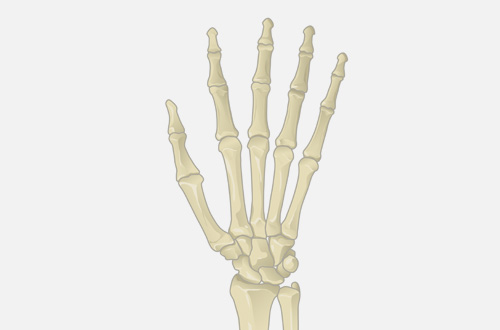Learning Center » Wrist / Hand

DeQuervain’s Tendonitis
Pain along the thumb-side of the wrist can result from inflammation of the tendon that lifts the thumb. There is a tunnel the tendon travels through, and the tunnel can become tight and inflamed, causing pain, snapping, or clicking. The classic scenario is a mother repeatedly picking up her new baby.
There is usually tenderness on the thumb side of the wrist. When you make a fist (with the thumb inside) and tilt the fist toward the small finger side, you can reproduce the pain (Finkelstein’s maneuver). Treatment starts with a simple brace to immobilize (and thus calm down) the thumb tendons. You can also add oral anti-inflammatory medication. If this is not effective, steroid injection into the tunnel may help. If repeated injections become necessary, surgical release of the tight tunnel is an option of last resort. Because this area is more superficial, there’s higher risk of skin discoloration (typically lightened) with a steroid injection.
Scaphoid Fracture
It is important to note, if pain in the thumb-side of the wrist occurs after trauma, you must be evaluated to rule out a broken wrist bone (scaphoid). This injury can be invisible on regular x-rays and has potentially devastating consequences for the wrist (arthritis) down the road. Sometimes it is necessary to immobilize the wrist in a cast for two weeks and repeat x-rays to be sure. Other times you can obtain an MRI or bone scan to diagnose the injury. If the wrist is broken, but in a good position, it can sometimes be treated for eight to 12 weeks in a cast. If it has shifted, or won’t heal in a cast, surgery is considered.
Trigger Finger
If you notice one finger, clicking, catching or even getting stuck when it’s bent, it may be trigger-finger. There is swelling of the flexor (bending) tendon to the finger that gets caught in a tunnel at the base of the finger. We see this more commonly in diabetics. If painful or bothersome, a steroid injection can usually calm it down. If multiple injections bring only temporary relief, then you may consider surgery. The procedure involves incising the tunnel to permanently open it, so the tendon no longer gets caught.
Mallet Finger
This is when the extensor (straightening) tendon is pulled off from the tip of the finger. If the extensor tendon is detached, you can no longer lift the tip of the finger, and so it drops into a flexed position. Typical treatment is non-surgical, and involves wearing a splint on the finger for six weeks, which keeps the tip straight. If this fails, or a bony injury causes an unstable finger joint, surgical re-attachment may be necessary.
Jersey Finger
This is the opposite of mallet finger, where the flexor (bending) tendon to the fingertip is torn from the finger tip. This commonly occurs with somebody grabbing a jersey as it pulls away from them. The finger most commonly involved is the ring finger because it’s the longest finger when all fingers are flexed. Treatment is typically surgical, because the tendon can retract into the hand, and thus will not heal on its own.
Carpal Tunnel Syndrome
Carpal tunnel syndrome refers to compression of the median nerve which typically give sensation to the thumb index and middle as well as half of the ring finger and provides some of the strength to the hand. Symptoms can include weakness or dropping items, as well as numbness or tingling while driving or performing repetitive tasks. Sometimes people are even woken up at night and have to shake the hand to get it to settle down. Initial treatment involves anti-inflammatories and wrist splint to reduce pressure in the carpal tunnel. If these measures fail, or if weakness sets in, it is sometimes advisable to undergo surgical release of the tunnel. Before surgery, it is prudent to obtain diagnostic testing whether it be nerve conduction studies by a neurologist, or ultrasound imaging, to confirm the diagnosis. Not everyone gets complete relief of symptoms after surgery, and the results depend mostly on the severity of nerve injury before surgery.
